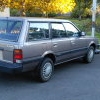Search the Community
Showing results for tags 'helicoil'.
-
Here are some notes from my project to replace bad spark plug threads with Helicoil thread inserts. I did this work on a 93 EA82 with the heads off the engine. Hope people find this helpful. I used the "Spark Plug Port Repair Kit" that is available in autoparts stores for about $50. See the firs...
-
- spark plug threads
- thread repair
-
(and 1 more)
Tagged with:
-
A few weeks ago I noticed a coolant leak, and tracked it down to an intake manifold gasket -- no problem, just pull the manifold and replace the gasket (or so I thought). I wound up busting a stuck bolt, and had to drill it out, unfortunately I managed to drill through a head mounting stud in the p...
-
My former White Wagon, the Weberized EA82, (now my "BumbleBeast") Was Leakin' Oil, but the Surprise is that it Wasn't from the Usual Places... it Was comin' from the Base of the Pipe Used to Pour Fresh Oil on the Engine, the one that Goes to one Head ... One of the Threads was Damaged, I don't know...








